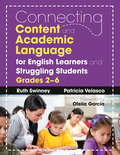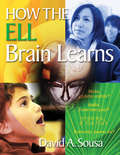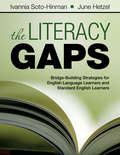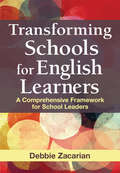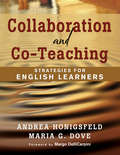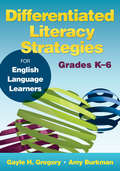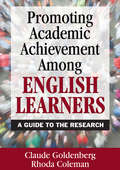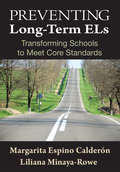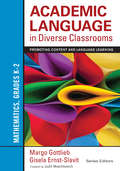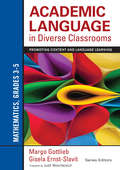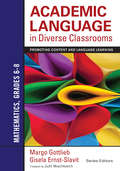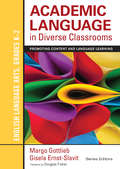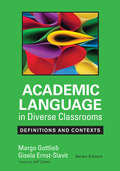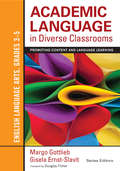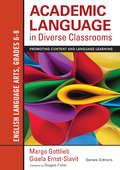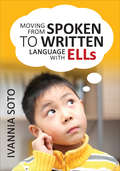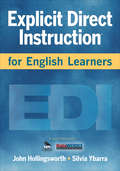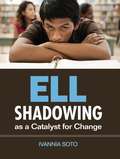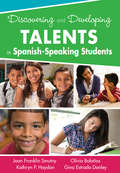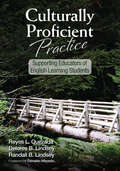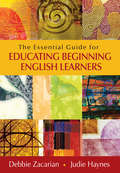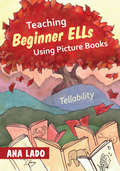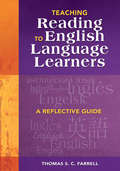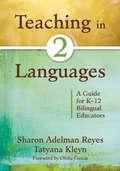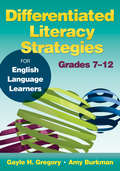- Table View
- List View
Connecting Content and Academic Language for English Learners and Struggling Students, Grades 2–6
by Ruth Swinney Patricia VelascoCreate unit plans that will empower your EL students Award-winning teacher Ruth Swinney and Harvard graduate Patricia Velasco focus on the careful planning needed to develop the academic language of all students. For English learners especially, it is critically important to integrate language development with content. What makes this book unlike any other is the detailed guidance it provides in: Encouraging verbal expression in the classroom Planning units that link language with content Using shared reading and writing, read alouds, and conversation
How the ELL Brain Learns
by Dr David A. SousaRaise your ELL success quotient and watch student achievement soar! How the ELL Brain Learns combines current research on how the brain learns language with strategies for teaching English language learners. Award-winning author and brain research expert David A. Sousa describes the linguistic reorganization needed to acquire another language after the age of 5 years. He supplements this knowledge with immediately applicable tools, including: A self-assessment pretest for gauging your understanding of how the brain learns languages Brain-compatible strategies for teaching both English learners across content areas An entire chapter about how to detect English language learning problems
The Literacy Gaps: Bridge-Building Strategies for English Language Learners and Standard English Learners
by Ivannia M. Soto June HetzelBuild bridges of support so English language learners and standard English learners can learn alongside their peers! This comprehensive, research-based guide helps teachers bridge multiple gaps and promote learning for English language learners (ELLs) and standard English learners (SELs). The authors provide strategies, examples, and tools to address: <p><p> The gap between students and texts: covering word recognition, background knowledge, comprehension, and academic language development <p> The gap between students and teachers: including sociocultural differences between teachers and students and teacher perceptions and expectations <p> The gap between students and their peers: discussing language proficiency differences, grouping strategies, and grade-level and schoolwide programs
Transforming Schools for English Learners: A Comprehensive Framework for School Leaders
by Debbie ZacarianPosition your school to successfully teach English learners Could your school be more effective at instructing its English learners? Whether you are just beginning to work with an emergent population or need to improve your program, this book provides a comprehensive framework for improving ELs’ academic performance and school engagement through visionary planning of EL education programming. The author addresses such critical topics as: Selecting the appropriate program model for your school Creating effective student course schedules for language development and content Making data-driven decisions using effective measures of student performance learning Effectively using Response to Intervention (RTI)
Collaboration and Co-Teaching: Strategies for English Learners
by Andrea M. Honigsfeld Maria G. DoveHelp ELLs achieve success with an integrated, collaborative program! This resource provides a practical guide to collaboration and co-teaching between general education teachers and ESL specialists to better serve the needs of ELLs. Offering classroom vignettes, step-by-step guidelines, ready-to-use resources, and in-depth case studies, the authors help educators: Understand the benefits and challenges of collaborative service delivery Teach content while helping students meet English language development goals Choose from a range of collaborative strategies and configurations, from informal planning and collaboration to a co-teaching partnership Use templates, planning guides, and other practical tools to put collaboration into practice
Differentiated Literacy Strategies for English Language Learners, Grades K–6
by Gayle H. Gregory Amy J. BurkmanEffective ways to help ELLs excel The key to successfully teaching English learners is focusing on literacy. Adapted from the highly successful Differentiated Literacy Strategies for Student Growth and Achievement in Grades K–6, this book provides a wealth of practical literacy strategies tailored for students who have had interrupted formal education or come from newly arrived immigrant populations. Teachers will find an instructional and assessment framework designed to promote these critical competencies: Functional literacy in phonics, spelling, and reading; Content-area literacy for vocabulary, concept attainment, and comprehension; Technological literacy for information searching, evaluation, and synthesis; Innovative literacy for creativity, growth, and lifelong learning.
Promoting Academic Achievement Among English Learners: A Guide to the Research
by Claude Goldenberg Rhoda ColemanDiscover the research and facts on what works in educating English learners! This comprehensive resource examines the research on promoting success among students who come to school knowing little or no English and translates current findings into specific recommendations for developing policies and programs for English learners. With illustrative scenarios throughout, this book gives educators and policy makers solid, research-based information about: Using students’ home language in academic programming Teaching English and academic content simultaneously School and district factors that affect achievement for English learners Sociocultural factors in success, including the influence of parents and families
Preventing Long-Term ELs: Transforming Schools to Meet Core Standards
by Margarita Espino Calderon Dr Liliana Minaya-Rowe10 keys to keeping English learners from falling through the cracks Students who struggle with English are likely to struggle with academic content throughout their school years. Many drop out. This practical guidebook’s 10 components for success will help educators at all levels close this achievement gap. Included are step-by-step instructions for integrating language, literacy, and subject matter to improve student learning. Key features include: A clearly articulated, evidence-based professional development program for effectively teaching English language learners Research-based coaching practices for improving instruction Ways to implement the program while concurrently meeting core standards and content objectives
Academic Language in Diverse Classrooms: Promoting Content and Language Learning
by Dr Margo Gottlieb Gisela Ernst-SlavitMake every student fluent in the language of learning. The Common Core and ELD standards provide pathways to academic success through academic language. Using an integrated Curricular Framework, districts, schools and professional learning communities can: Design and implement thematic units for learning Draw from content and language standards to set targets for all students Examine standards-centered materials for academic language Collaborate in planning instruction and assessment within and across lessons Consider linguistic and cultural resources of the students Create differentiated content and language objectives Delve deeply into instructional strategies involving academic language Reflect on teaching and learning
Academic Language in Diverse Classrooms: Promoting Content and Language Learning
by Dr Margo Gottlieb Gisela Ernst-SlavitMake every student fluent in the language of learning. The Common Core and ELD standards provide pathways to academic success through academic language. Using an integrated Curricular Framework, districts, schools and professional learning communities can: Design and implement thematic units for learning Draw from content and language standards to set targets for all students Examine standards-centered materials for academic language Collaborate in planning instruction and assessment within and across lessons Consider linguistic and cultural resources of the students Create differentiated content and language objectives Delve deeply into instructional strategies involving academic language Reflect on teaching and learning
Academic Language in Diverse Classrooms: Promoting Content and Language Learning
by Dr Margo Gottlieb Gisela Ernst-SlavitMake every student fluent in the language of learning. The Common Core and ELD standards provide pathways to academic success through academic language. Using an integrated Curricular Framework, districts, schools and professional learning communities can: Design and implement thematic units for learning Draw from content and language standards to set targets for all students Examine standards-centered materials for academic language Collaborate in planning instruction and assessment within and across lessons Consider linguistic and cultural resources of the students Create differentiated content and language objectives Delve deeply into instructional strategies involving academic language Reflect on teaching and learning
Academic Language in Diverse Classrooms: Promoting Content and Language Learning
by Dr Margo Gottlieb Gisela Ernst-SlavitMake every student fluent in the language of learning. The Common Core and ELD standards provide pathways to academic success through academic language. Using an integrated Curricular Framework, districts, schools and professional learning communities can: Design and implement thematic units for learning Draw from content and language standards to set targets for all students Examine standards-centered materials for academic language Collaborate in planning instruction and assessment within and across lessons Consider linguistic and cultural resources of the students Create differentiated content and language objectives Delve deeply into instructional strategies involving academic language Reflect on teaching and learning
Academic Language in Diverse Classrooms: Definitions and Contexts
by Dr Margo Gottlieb Gisela Ernst-SlavitEnsure your school speaks the language of success! Since the introduction of the Common Core, schools realize the necessity for a deep understanding of academic language as a stepping stone to academic achievement. The expectations for more robust curriculum, instruction, and assessment require administrators, teachers, and students to retool for academic success. This companion volume to Margo Gottlieb and Gisela Ernst-Slavit’s six-book series on academic language provides a thorough overview of key concepts and effective practices. Optimized for curricular planning and in-classroom reference, with particular attention to linguistically and culturally diverse students, the book includes: Definitions and examples of the dimensions of academic language. A step-by-step template for teachers to incorporate academic language into their planning for student learning. Graphic models that illustrate academic language use across the content areas.
Academic Language in Diverse Classrooms: Promoting Content and Language Learning
by Dr Margo Gottlieb Gisela Ernst-SlavitMake every student fluent in the language of learning. The Common Core and ELD standards provide pathways to academic success through academic language. Using an integrated Curricular Framework, districts, schools and professional learning communities can: Design and implement thematic units for learning Draw from content and language standards to set targets for all students Examine standards-centered materials for academic language Collaborate in planning instruction and assessment within and across lessons Consider linguistic and cultural resources of the students Create differentiated content and language objectives Delve deeply into instructional strategies involving academic language Reflect on teaching and learning
Academic Language in Diverse Classrooms: Promoting Content and Language Learning
by Dr Margo Gottlieb Gisela Ernst-SlavitMake every student fluent in the language of learning. The Common Core and ELD standards provide pathways to academic success through academic language. Using an integrated Curricular Framework, districts, schools and professional learning communities can: Design and implement thematic units for learning Draw from content and language standards to set targets for all students Examine standards-centered materials for academic language Collaborate in planning instruction and assessment within and across lessons Consider linguistic and cultural resources of the students Create differentiated content and language objectives Delve deeply into instructional strategies involving academic language Reflect on teaching and learning
Moving From Spoken to Written Language With ELLs
by Ivannia M. SotoMastering spoken language is the key to writing success for English Language Learning ELLs struggle to meet the writing demands of the Common Core State Standards. In this book, ELL expert Ivannia Soto demonstrates how oral language development is the key to building writing skills. She offers educators a powerful set of tools for implementation at both classroom and policy levels, including: • Exciting spoken techniques such as Socratic Seminar, Frayer model and Think-Pair-Share that build vocabulary and extend into academic writing • Approaches to teaching three essential styles of writing: argumentative, procedural, and narrative • Sample lesson plans and graphic organizer templates
Explicit Direct Instruction for English Learners
by John R. Hollingsworth Silvia E. YbarraBoost achievement for English learners in all subject areas! Building ELLs' language skills while teaching content is about to get easier. Hollingsworth and Ybarra combine the best of educational theory, brain research, and data analysis to bring you explicit direct instruction (EDI): a proven method for creating and delivering lessons that help students learn more and learn faster. Through classroom examples and detailed sample lessons, you'll learn how to: Craft lessons that ELs can learn the first time they're taught Check for understanding throughout each lesson Embed vocabulary development across the curriculum Address listening, speaking, reading, and writing in all lessons
ELL Shadowing as a Catalyst for Change
by Ivannia M. SotoExperience a day in the life of an ELL What if you could barely understand what your teacher was saying? ELL shadowing helps teachers experience the classroom from the student’s point of view. The author describes how to implement this easily accessible form of professional development, outlines specific strategies for adapting instruction to engage ELLs, and provides supporting videos on a companion website. Benefits include: Increased teacher sensitivity to ELLs’ school experiences A heightened sense of urgency to help ELLs learn academic language and content Improved classroom instruction that spreads throughout schools and districts More engaged students who are more likely to stay in school and reach their potential
Discovering and Developing Talents in Spanish-Speaking Students
by Joan F. Smutny Kathryn P. Haydon Olivia G. Bolanos Gina M. Danley¡Atención! Recognize the strengths of Spanish-speaking students! How do you nurture the gifts and talents of the growing population of Hispanic students? This book provides teachers and leaders with the skills needed to uncover each child’s abilities and ultimately boost achievement for gifted Spanish-speaking students. Packed with strategies that teachers can use immediately to enhance instruction and assessment, this book shows how to: Recognize students’ unique strengths Identify and develop the gifts of bilingualism and different cultures Create challenging learning experiences for every student in the class Adapt tools and strategies to meet each learner’s unique needs Connect with parents and the greater Spanish-speaking community
Culturally Proficient Practice: Supporting Educators of English Learning Students
by Reyes L. Quezada Delores B. Lindsey Randall B. LindseyHelp your English learning students achieve academic success! Designed to empower educators to become agents of change in their classrooms, schools, and communities, this guide introduces the principles of Cultural Proficiency and how they can help improve educators’ ability to effectively teach English language learners. This book features: <p><p> Activities that build core Cultural Proficiency skills and promote personal transformation <p> A chapter-by-chapter rubric for working effectively with English learning students <p> A conversation-starting case story featuring the River View School District <p> Strategies for using action research to improve the success of English learning students
The Essential Guide for Educating Beginning English Learners
by Debbie Zacarian Judie HaynesPut all English learners on the path to success—right from the start! As more beginning ELs enroll in schools every year, educators need a realistic framework for addressing the varied needs of this growing population. In this practical resource, the authors provide templates, tools, and vignettes illustrating real-world challenges to help teachers and administrators: Learn strategies for teaching beginning level ELs across the curriculum Create a welcoming environment for students and families Reach out to students from both literacy and non-literacy-oriented homes Design programs that meet the needs of beginning ELs and students with limited or interrupted formal education (SLIFE)
Teaching Beginner ELLs Using Picture Books: Tellability
by Ana L. LadoPicture your beginning ELLs reading their way to success! For beginning ELLs, a picture really is worth a thousand words! Picture books are useful tools for building important language and social foundations that students may miss through traditional instruction. Ana Lado provides all the tools you’ll need to engage ELLs of any age with picture books, including how to: Design lessons around picture books Select appropriate titles using specific criteria Incorporate fun and engaging strategies like singing and reenacting Access the book’s searchable online database to find the right book Integrate picture-book learning to facilitate development of English Language Proficiency
Teaching Reading to English Language Learners: A Reflective Guide
by Thomas S. FarrellThis resource offers practical methods for helping ELLs succeed in reading, with strategies to increase fluency and comprehension, teach vocabulary and text structure, and more.
Teaching in Two Languages: A Guide for K–12 Bilingual Educators
by Sharon Adelman Reyes Tatyana KleynGrounded in the latest research, this book provides classroom-ready strategies for balancing instruction in two languages and meeting the unique challenges of educating English language learners.
Differentiated Literacy Strategies for English Language Learners, Grades 7–12
by Gayle H. Gregory Amy J. Burkman100 ways to keep adolescent ELLs engaged This versatile handbook is for middle school and high school educators who need to differentiate literacy instruction for adolescent ELL students at various stages of literacy competency. Adapted from the highly successful Differentiated Literacy Strategies for Student Growth and Achievement in Grades 7–12, the authors use brain-based strategies and texts that appeal to older learners who may have had interrupted formal education or come from newly arrived immigrant populations. More than 100 hands-on tools help teachers develop students’ competencies in: Content areas, including vocabulary, concept attainment, and comprehension Technology, such as information searching, evaluation, and synthesis Creative applications and 21st century skills ·
